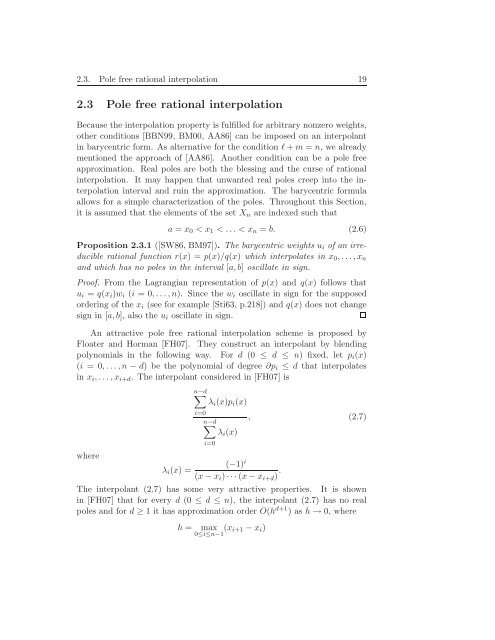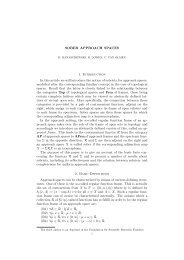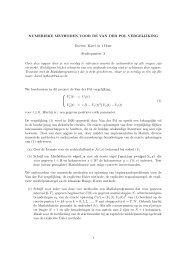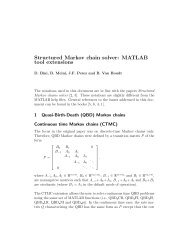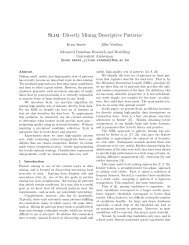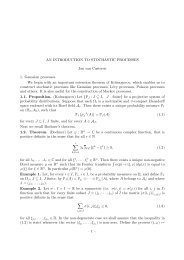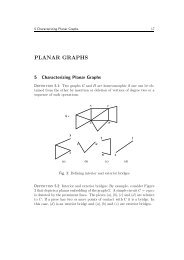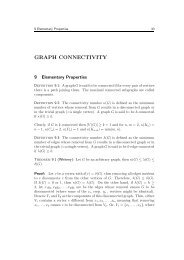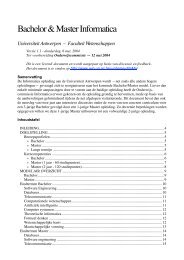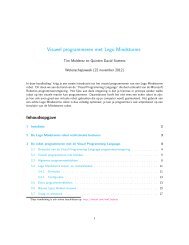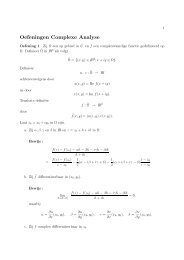Practical Rational Interpolation of Exact and Inexact Data Theory ...
Practical Rational Interpolation of Exact and Inexact Data Theory ...
Practical Rational Interpolation of Exact and Inexact Data Theory ...
You also want an ePaper? Increase the reach of your titles
YUMPU automatically turns print PDFs into web optimized ePapers that Google loves.
2.3. Pole free rational interpolation 19<br />
2.3 Pole free rational interpolation<br />
Because the interpolation property is fulfilled for arbitrary nonzero weights,<br />
other conditions [BBN99, BM00, AA86] can be imposed on an interpolant<br />
in barycentric form. As alternative for the condition ℓ + m = n, we already<br />
mentioned the approach <strong>of</strong> [AA86]. Another condition can be a pole free<br />
approximation. Real poles are both the blessing <strong>and</strong> the curse <strong>of</strong> rational<br />
interpolation. It may happen that unwanted real poles creep into the interpolation<br />
interval <strong>and</strong> ruin the approximation. The barycentric formula<br />
allows for a simple characterization <strong>of</strong> the poles. Throughout this Section,<br />
it is assumed that the elements <strong>of</strong> the set Xn are indexed such that<br />
a = x0 < x1 < ... < xn = b. (2.6)<br />
Proposition 2.3.1 ([SW86, BM97]). The barycentric weights ui <strong>of</strong> an irreducible<br />
rational function r(x) = p(x)/q(x) which interpolates in x0,...,xn<br />
<strong>and</strong> which has no poles in the interval [a,b] oscillate in sign.<br />
Pro<strong>of</strong>. From the Lagrangian representation <strong>of</strong> p(x) <strong>and</strong> q(x) follows that<br />
ui = q(xi)wi (i = 0,... ,n). Since the wi oscillate in sign for the supposed<br />
ordering <strong>of</strong> the xi (see for example [Sti63, p.218]) <strong>and</strong> q(x) does not change<br />
sign in [a,b], also the ui oscillate in sign.<br />
An attractive pole free rational interpolation scheme is proposed by<br />
Floater <strong>and</strong> Horman [FH07]. They construct an interpolant by blending<br />
polynomials in the following way. For d (0 ≤ d ≤ n) fixed, let pi(x)<br />
(i = 0,... ,n − d) be the polynomial <strong>of</strong> degree ∂pi ≤ d that interpolates<br />
in xi,... ,xi+d. The interpolant considered in [FH07] is<br />
where<br />
λi(x) =<br />
n−d <br />
λi(x)pi(x)<br />
i=0<br />
n−d<br />
<br />
λi(x)<br />
i=0<br />
(−1) i<br />
(x − xi) · · · (x − xi+d) .<br />
, (2.7)<br />
The interpolant (2.7) has some very attractive properties. It is shown<br />
in [FH07] that for every d (0 ≤ d ≤ n), the interpolant (2.7) has no real<br />
poles <strong>and</strong> for d ≥ 1 it has approximation order O(h d+1 ) as h → 0, where<br />
h = max<br />
0≤i≤n−1 (xi+1 − xi)


